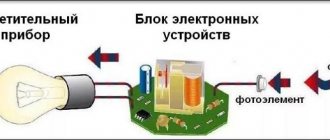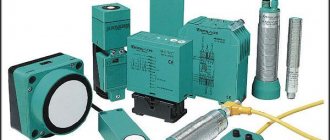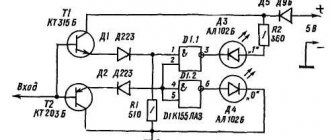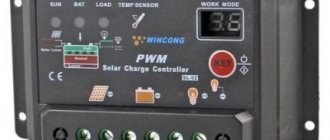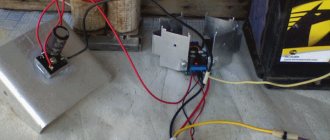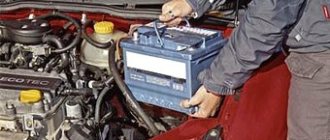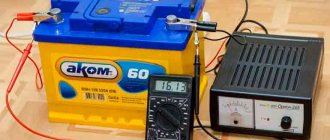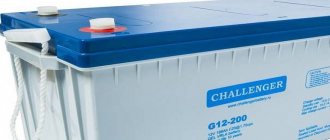Device Description
Before using the indicator, it is important to gently tap it with any hard object .
After such exposure, air bubbles, which may interfere with inspection of the device, rise to the surface. As a result, the shade of the sensor can be viewed in more detail. While charging the device, the density of the electrolyte begins to increase near the electrodes themselves. Above the location of the electrodes, the density begins to increase significantly due to the onset of diffusion. The battery indicator reacts to such a process, which in some cases can lead to an incorrect result. Even though the battery is 100% charged, the indicator may remain black.
This process can be explained by the fact that an electrolyte with a high density does not have time to completely mix with an electrolyte of lower density.
The process of mixing electrolytes through diffusion can continue for several days. The condition of the battery can be definitively assessed using a measurement made by a special tester.
Battery Specifications
The main types of batteries used:
- Alkaline – Ni-Cd,
- Ni-MH – nickel metal hydride,
- acid - batteries for cars,
- Li-ion – lithium-ion,
- Li-po – lithium polymer.
When operating a battery, it is necessary to take into account its functional characteristics, such as:
- capacity value,
- output voltage,
- sizes,
- How much does it weigh,
- permissible minimum voltage,
- lifetime,
- efficiency,
- operating temperature range,
- operating charge and discharge current.
For your information. All parameters are indicated for 20 or 25 °C.
A car battery (battery) consists of 6 series-connected battery sections with a supply voltage of each 2.1-2.16 V; on a good battery the voltage is 13-13.5 V.
Important! The voltage should not be reduced below 9 volts, since due to the peculiarities of the processes occurring in the batteries, the density decreases, which increases the freezing temperature of the electrolyte and accelerates the destruction of the electrodes. In turn, the battery life is reduced.
Main types of charge
The battery plays a major role when starting the car engine. How successful this start will be depends largely on recharging the battery .
But not every driver monitors the battery charge level. In this case, the chance that one day the car simply will not be able to start due to battery failure increases several times. Checking the charging of the device itself is considered quite simple. In this case, you just need to check the voltage in the car battery from time to time with a special diagnostic device - a voltmeter or multimeter. But it is much simpler and easier if the user has a special indicator in stock that will show the general state of charge of the device. It is precisely these indicators for car batteries that are in great demand at present.
Modern technologies continue to actively develop; in the automobile production sector they are trying in every possible way to make travel by transport and its maintenance more convenient. On modern cars, the on-board computer, in addition to various functions, includes battery voltage indicators.
But such extensions are not available in every car. On older models there may be an analog voltmeter, which will not be easy to determine what state the system is in. For beginners in the automotive field, it is best to first study the vehicle battery charging rate and only then begin to determine the indicator. We recommend: Methods for training and restoring a car battery
Recently, an increasing number of indicators for determining battery charge have begun to appear on the market. They began to be produced for batteries, which are a hydrometer, as well as for additional displays in the car interior.
Many countries produce these types of indicators. They are quite simple to place inside the vehicle and connect to the on-board screen. In addition, the Internet presents a large number of simple schemes for creating charge indicators with your own hands. There are no particular difficulties in this process.
What to do if the electrolyte becomes cloudy
Generator VAZ 2107: operating principle and connection diagram
First, you should use standard prevention methods. That is, add electrolyte as necessary or simply dilute the acid with increased density with special distilled water.
You should also use a charger or simply try to replenish the charge if it drops below the permissible values, due to the active operation of the generator.
When such measures do not help, we have to look for alternative ways out of situations.
The characteristics of the changing electrolyte may vary. Experts distinguish several options:
- gray working fluid in the battery;
- cloudy mixture of acid and water;
- brown electrolyte;
- black liquid.
Each option should now be considered separately, depending on the color.
Grey
In its normal working state, the acid-water mixture has no color, that is, it remains completely transparent.
But it happens that motorists notice changes. This happens in one car battery bank or in all of them at the same time, when the electrolyte is completely painted dark gray.
In this case, the most likely cause will be a strong discharge.
To return the battery to service, it is recommended to drain the old working fluid, and then fill in a new, fresh and high-quality mixture of purified, prepared acid and distillate.
After this, cyclic charging is required. Current and voltage are selected based on the recommendations prescribed by the manufacturer.
Cloudy color
It also happens that cloudy, as if dirty, electrolyte appears in one battery bank or in several battery banks at once.
If a cloudy mixture is detected during testing, this may be due to the use of a low-quality acid-water mixture or the use of tap water poured literally from the tap.
It also happens that turbidity appears in the entire battery, that is, when checking all available cans. In this situation, the problem is more likely to be the low quality of the purchased battery.
To restore the battery's functionality, you can replace the mixture of water and acid, and then follow the charging procedure according to the instructions.
Brown
And in some cases, the acid-water mixture has a brown tint. It is quite easy to distinguish it from a gray or simply cloudy electrolyte.
The main reason that the fluid turns brown is that the battery is overcharged. Or the plates were severely exposed during charging due to a lack of electrolyte.
It is best when the problem is observed only on the side of one can and the brown color is not very saturated. Then the problem can be solved by adding fresh electrolyte.
If the shade is dark enough, you will need to completely change the composition of the acid and distillate used in the entire battery, and then carry out a sequential charging cycle.
Black
Motorists have repeatedly noted that when opening the battery, they noticed black electrolyte in the battery of their vehicle. And here it is logical to ask what to do in such a situation.
An acidic working fluid that has turned black is unlikely to be restored. That is, a complete replacement will be required here.
Blackening of a mixture of acid and water is possible when the plates are destroyed and lead particles accumulate at the bottom of the cans.
It is lead that contributes to such intense coloring.
If blackening is observed in only one of the cans, first try replacing the working fluid there. In some cases, it is actually possible to restore the operation of the device. But this is only allowed in a situation where there is no short circuit between the plates.
Otherwise, you will have to completely change the entire electrolyte or the battery itself with a new one. Shedding of lead-based internal plates is a strong argument and reason to think about buying a new car battery.
Built-in indicator
Built-in charge indicator models are installed mainly on maintenance-free car batteries.
This indicator includes a special float, which is also called a hydrometer. It is necessary to consider its structure and principle of operation in more detail. Such a device includes the following parts: indicator eye, light guide, float, indicator leg. The operating principle of many hydrometer models is similar to each other. The indicator can take three different values in the following cases:
- As the battery charges, the density of the electrolyte increases. In this case, the spherical float is painted green, rises up the pipe, and can be easily distinguished through the indicator eye. Most often, a green-colored ball floats to the surface when the device is charged 65 percent or more.
- If the ball sinks in the electrolyte, this indicates a low density according to the norm. In this case, the charge in the battery does not reach the required level. At this time, through the indicator eye, the user will be able to see a tube painted black. This indicates that the device is not charging enough. In some types of indicators, a red ball is specially installed, which rises through the pipe at a reduced density. In this case, the sensor color will be red when viewed.
- There is another possible case of low electrolyte levels. Here, through the indicator eye, the surface of the electrolyte will be visible. To improve the situation, you need to add distilled water or a special electrolyte to the device. In the case of a maintenance-free battery, such a procedure will be extremely difficult.
Is it possible to fix the problem?
The main thing is not to miss messages issued by the operating system, which also monitors battery performance. When problems arise with the battery, the OS sends a message about its damage - as a rule, it “crawls out” on the right. If the system does not produce such a message and “believes” that everything is fine with the battery pack, most likely there is a problem with the charger itself.
It is important to keep in mind that if the battery is damaged, it is no longer possible to repair it. In the best case, it will have to be either completely changed or a partial replacement of elements
About laptop battery repair →
The charger can simply be disassembled into parts and tested using a multimeter. Most likely, the wiring has frayed or the contacts have come loose - this problem can be fixed with your own hands. However, if the capacitor burns out, you will have to look for a new, suitable charger.
Factors of inaccuracy
Such a built-in indication system on the car battery helps to fully assess in advance the discharge of the car battery. But you should not fully rely on the readings that the hydrometer provides to the owner. If you study a large number of customer reviews about the functioning of such a device, you will find that they quite often show inaccurate values and quickly break down. Several factors lead to this:
- The indicator is built into only one of the car's six batteries. This means that indicators of the density and overall charge of the device will be read only from a single bank. Since no communication has been established between them, one can only make guesses about the position of the remaining cans. For example, in this device the electrolyte level may be normal, but in others it will be at an insufficient level. The process of evaporation of water from the electrolyte is quite different among the banks (in extreme cases this procedure is carried out at a more accelerated pace).
- The sensor is made of plastic or glass. The plastic parts of the device may crack or become damaged when exposed to high temperatures and sudden cooling. As a result, the owner will receive inaccurate data.
- The density of the electrolyte directly depends on the surrounding temperature. The hydrometer does not consider this fact in any way when deriving the result. For example, on a cooled electrolyte it may indicate normal density, although in fact it will be significantly reduced.
We recommend: How to properly start a car in severe frost
It is important to remember that to check the battery charge using the day indicator built into the car, you need to open the hood, rub the peephole and look into it. Many car owners rarely look under the hood. It is very important to have a special device right in the car that will show the battery charge indicator. Such devices are created by car manufacturers themselves and other distinctive companies.
Today, quite interesting devices are going on sale for monitoring the amount of battery charge by measuring the voltage in it.
Printed circuit board and assembly parts
The printed circuit board is made of single-sided foil PCB measuring 40 by 37 mm, which can be downloaded here. It is designed for mounting DIP elements of the following type:
- MLT-0.125 W resistors with an accuracy of at least 5% (E24 series) R1, R2, R3, R4, R7, R9, R10, R11 – 1 kOhm, R5, R8 – 5.1 kOhm, R6, R12 – 10 kOhm;
- any low-power diode VD1 with a reverse voltage of at least 30 V, for example, 1N4148;
- Zener diode VD2 is low-power with a stabilization voltage of 6.2 V. For example, KS162A, BZX55C6V2;
- LEDs LED1-LED5 – indicator type AL307 of any color.
This circuit can be used not only to monitor the voltage on 12 volt batteries. By recalculating the values of the resistors located in the input circuits, we get an LED indicator for any desired voltage. To do this, you should set the threshold voltages at which the LEDs will turn on, and then use the formulas for recalculating the resistances given above.
DC-12V indicator
Such a device can be found in the store in the form of a designer.
It is this that can be freely used by those who are well versed in soldering and electrical engineering. The DC-12 V indicator gives the owner the opportunity to regularly check the battery charge indicators and the operating principle of the relay itself. The indicator can be purchased as a special part for the car; it can be assembled independently. The price for such a battery charge level indicator will range from 300 to 400 rubles. The main distinguishing features of such a device include the following:
- voltage indicator, which ranges from 2.5 to 18 volts;
- maximum current consumption up to 20 mA;
- The total size of the printed circuit board is 43*20 millimeters.
Battery charging controller
To monitor the condition of the battery while the charger is operating, we make a battery charge controller. The device circuit and components used are as accessible as possible, while at the same time providing complete control over the battery recharging process.
The operating principle of the controller is as follows: as long as the voltage on the battery is below the charging voltage, the green LED lights up. As soon as the voltage is equal, the transistor opens, lighting up the red LED. Changing the resistor in front of the base of the transistor changes the voltage level required to turn on the transistor.
This is a universal monitoring circuit that can be used for both high-power car batteries and miniature lithium batteries.
Please rate the article. We tried our best:)
Did you like the article? Tell us about her! You will help us a lot :)
TMS device panel
This device is best suited for those owners who have a second battery built into their car. The device looks like an aluminum panel with a special voltmeter and a toggle switch for switching between batteries. The place of production is considered to be China, the cost reaches 1,500 rubles.
In stores you can find car battery indicators with a 12-volt charge level from the manufacturer Faria, located in the USA. But the cost for such devices is very high and ranges from four to five thousand rubles. For that kind of money it will be much easier to buy a new battery.
